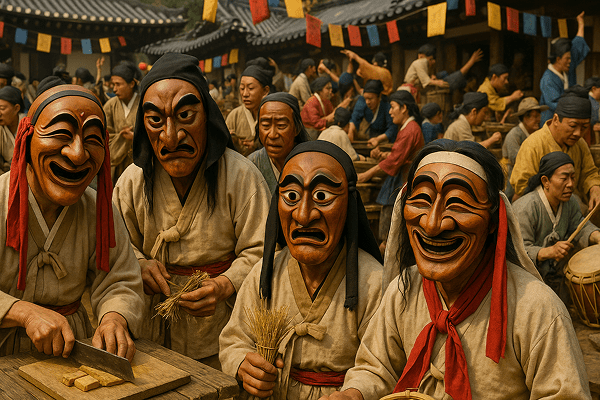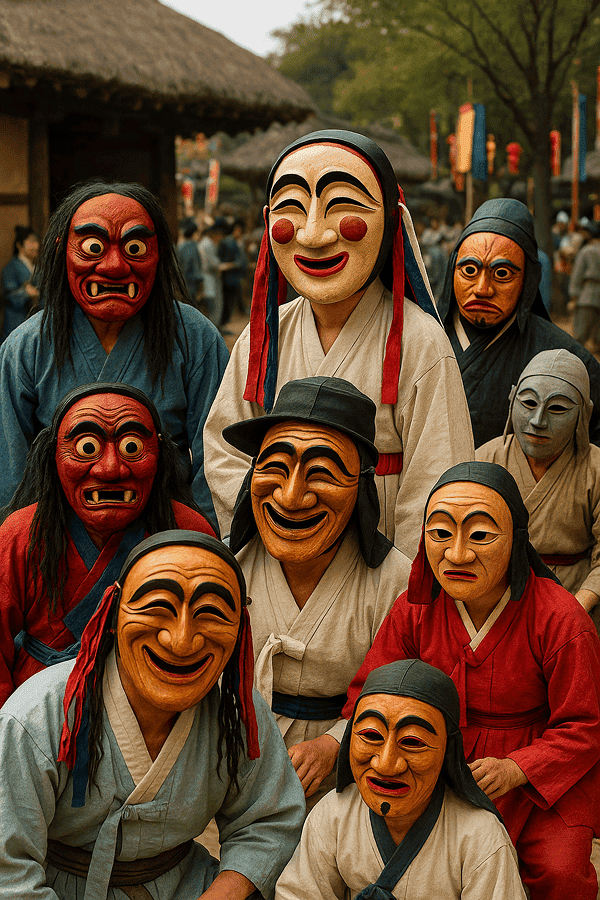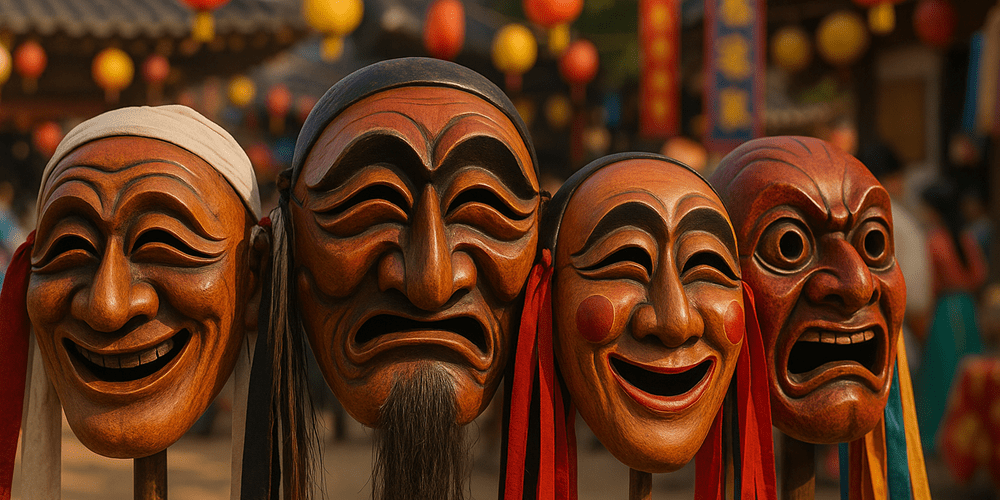Korean Festival Masks, known as “tal” (탈), are among the most vivid and captivating expressions of Korean cultural heritage. These masks are celebrated for their dramatic features — exaggerated facial expressions, vibrant colors, and skillful craftsmanship. Typically handcrafted from wood, paper-mâché, or gourd, festival masks often display stylized smiles, angry grimaces, or whimsical, satirical faces. They are closely associated with Korea’s mask dance dramas (talchum), shamanic rituals, and folk festivals that have been cherished for centuries. Korean Festival Masks are rooted in regional traditions, particularly in areas such as Hahoe, Andong, and Tongyeong, and their widespread use dates back to the Goryeo and Joseon dynasties.
Historical Origins of Festival Masks in Korea
The origins of Korean Festival Masks can be traced to ancient shamanic and animistic rituals. The Korean word “tal” means “mask” but also connotes the face or the persona one adopts. Early masks were likely crafted from simple materials and used in rites to appease spirits, invoke blessings, and ward off misfortune. Over centuries, as Korean society evolved and Buddhist and Confucian influences merged with local customs, the role of masks expanded beyond shamanic rites to include theatrical and communal functions. The Goryeo (918–1392) and Joseon (1392–1897) periods saw the flourishing of talchum and other mask-based performances, with masks becoming more sophisticated and artistically refined. Historical records, such as the “Samguk Sagi” and documented temple rituals, reference the use of masks in both entertainment and spiritual contexts. Notable archaeological finds, including ancient wooden masks and festival artifacts, underscore the deep historical roots of this tradition.
Cultural Significance and Symbolism of Korean Festival Masks
Korean Festival Masks carry profound symbolic meaning within their native culture. They serve as vessels that allow performers to embody spirits, ancestors, or archetypal characters from folklore and legend. Symbolically, the exaggerated features of the masks — whether grotesque, comical, or beautiful — reflect universal human emotions and social commentary. In shamanic and folk settings, masks are believed to provide protection, ensure fertility, and drive away evil spirits. Many masks are linked to specific myths or legendary figures, such as the noble Yangban, the flirtatious Bune, or the mischievous Choraengi. The communal context of mask-wearing, especially during festivals, reinforces social cohesion and allows for playful subversion of hierarchy and tradition.

Materials and Craft Techniques of Korean Festival Masks
Traditional Korean Festival Masks are most commonly made from alder, willow, or pine wood, which are carefully selected for their lightness and spiritual purity. In some regions, artisans use gourds, layered cloth, or paper-mâché. The crafting process is both technical and ritualistic: materials are prepared and purified, and the mask is often carved, hollowed, and sanded by hand. Artists (taljang) then paint the mask with natural pigments — red, black, white, and sometimes gold — using fine brushes to accentuate facial features and symbolic patterns. Decorative elements such as horsehair, fabric ribbons, or metal ornaments are added for theatrical flair. Regional differences in technique and design are pronounced: Hahoe masks are known for their asymmetry and lively forms, while Tongyeong masks are more angular and stylized. Color symbolism is central — red represents protection and vitality, black signals authority, and white suggests purity or the supernatural.
Functions and Use of Korean Festival Masks
The primary function of Korean Festival Masks is in performance — most notably in talchum, the traditional mask dance-drama. These performances blend music, dance, satire, and ritual, often enacting stories that lampoon the upper classes, explore themes of love and jealousy, or address social injustices. Masks are also used in shamanic ceremonies (kut) to invoke spirits or ancestors, and in seasonal festivals to celebrate planting, harvest, or the lunar new year. Over time, the role of masks has expanded from strictly ritual and theatrical uses to include parades, exhibitions, and even contemporary art installations. Today, festival masks are featured in cultural festivals across Korea and are increasingly recognized as symbols of national identity and artistic excellence.
Regional Variations in Korean Festival Masks
Korean Festival Masks display wide regional diversity, reflecting local myths, dialects, and customs. The Hahoe masks of Andong are UNESCO-listed and renowned for their expressive, asymmetrical features. The Bongsan Talchum masks are known for their vibrant colors and humorous characters, while the Tongyeong and Goseong masks are more stylized and abstract. Each region has developed its own repertoire of mask types and dance styles, tailored to local stories and community needs. Compared to similar traditions in Japan and China, Korean festival masks are distinctive for their blend of satire, spirituality, and social commentary.

Famous Examples and Collections of Korean Festival Masks
Many iconic Korean festival masks are preserved in museums and private collections. The Hahoe Mask Museum in Andong is world-famous for its comprehensive display of original festival masks, including those used in historic performances. The National Museum of Korea and the National Folk Museum of Korea in Seoul also hold significant collections, featuring masks from the Silla, Goryeo, and Joseon periods. Important archaeological discoveries, such as ancient wooden masks and ceremonial artifacts from temple sites, provide insight into the development of mask culture.
Influence of Korean Festival Masks on Art and Culture
The influence of Korean Festival Masks extends into nearly every aspect of Korean art and culture. Their bold forms inspire painters, sculptors, and designers, and their motifs appear in film, literature, and music. Elements of mask design are visible in contemporary fashion, jewelry, and graphic arts. Festival masks play a critical role in cultural preservation, helping to keep alive stories, values, and aesthetic ideals that have shaped Korean identity for generations.
Modern Status and Preservation of Korean Festival Mask Traditions
Today, Korean Festival Mask traditions are actively maintained and revitalized by master artisans, cultural organizations, and government initiatives. Artisans continue to pass down mask-making skills through family and apprentice systems, while festivals and mask dance competitions draw large audiences nationwide. Educational programs, museum workshops, and international exhibitions ensure that this tradition remains a dynamic part of Korea’s cultural landscape.
